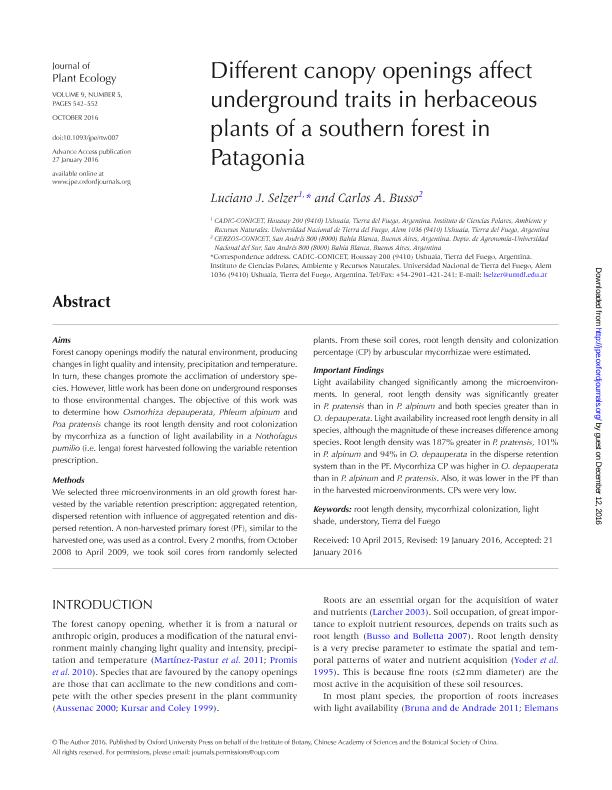Mostrar el registro sencillo del ítem
dc.contributor.author
Selzer, Luciano Javier

dc.contributor.author
Busso, Carlos Alberto

dc.date.available
2017-10-05T17:44:35Z
dc.date.issued
2016-10
dc.identifier.citation
Selzer, Luciano Javier; Busso, Carlos Alberto; Different canopy openings affect underground traits in herbaceous plants of a southern forest in Patagonia; Oxford University Press; Journal Of Plant Ecology-uk; 9; 5; 10-2016; 542-552
dc.identifier.issn
1752-9921
dc.identifier.uri
http://hdl.handle.net/11336/25984
dc.description.abstract
Aims
Forest canopy openings modify the natural environment, producing changes in light quality and intensity, precipitation and temperature. In turn, these changes promote the acclimation of understory species. However, little work has been done on underground responses to those environmental changes. The objective of this work was to determine how Osmorhiza depauperata , Phleum alpinum and Poa pratensis change its root length density and root colonization by mycorrhiza as a function of light availability in a Nothofagus pumilio (i.e. lenga) forest harvested following the variable retention prescription.
Methods
We selected three microenvironments in an old growth forest harvested by the variable retention prescription: aggregated retention, dispersed retention with influence of aggregated retention and dispersed retention. A non-harvested primary forest (PF), similar to the harvested one, was used as a control. Every 2 months, from October 2008 to April 2009, we took soil cores from randomly selected plants. From these soil cores, root length density and colonization percentage (CP) by arbuscular mycorrhizae were estimated.
Important Findings
Light availability changed significantly among the microenvironments. In general, root length density was significantly greater in P. pratensis than in P. alpinum and both species greater than in O. depauperata. Light availability increased root length density in all species, although the magnitude of these increases difference among species. Root length density was 187% greater in P. pratensis, 101% in P. alpinum and 94% in O. depauperata in the disperse retention system than in the PF. Mycorrhiza CP was higher in O. depauperata than in P. alpinum and P. pratensis. Also, it was lower in the PF than in the harvested microenvironments. CPs were very low.
dc.format
application/pdf
dc.language.iso
eng
dc.publisher
Oxford University Press

dc.rights
info:eu-repo/semantics/openAccess
dc.rights.uri
https://creativecommons.org/licenses/by-nc-sa/2.5/ar/
dc.subject
Root Length Density
dc.subject
Mycorrhizal Colonization
dc.subject
Light-Shade
dc.subject
Understory
dc.subject
Tierra del Fuego
dc.subject.classification
Bioquímica y Biología Molecular

dc.subject.classification
Ciencias Biológicas

dc.subject.classification
CIENCIAS NATURALES Y EXACTAS

dc.title
Different canopy openings affect underground traits in herbaceous plants of a southern forest in Patagonia
dc.type
info:eu-repo/semantics/article
dc.type
info:ar-repo/semantics/artículo
dc.type
info:eu-repo/semantics/publishedVersion
dc.date.updated
2017-07-27T12:26:04Z
dc.journal.volume
9
dc.journal.number
5
dc.journal.pagination
542-552
dc.journal.pais
Reino Unido

dc.journal.ciudad
Oxford
dc.description.fil
Fil: Selzer, Luciano Javier. Consejo Nacional de Investigaciones Científicas y Técnicas. Centro Austral de Investigaciones Científicas; Argentina
dc.description.fil
Fil: Busso, Carlos Alberto. Consejo Nacional de Investigaciones Científicas y Técnicas. Centro Científico Tecnológico Conicet - Bahía Blanca. Centro de Recursos Naturales Renovables de la Zona Semiárida. Universidad Nacional del Sur. Centro de Recursos Naturales Renovables de la Zona Semiárida; Argentina
dc.journal.title
Journal Of Plant Ecology-uk

dc.relation.alternativeid
info:eu-repo/semantics/altIdentifier/url/https://academic.oup.com/jpe/article-lookup/doi/10.1093/jpe/rtw007
dc.relation.alternativeid
info:eu-repo/semantics/altIdentifier/doi/http://dx.doi.org/10.1093/jpe/rtw007
Archivos asociados
